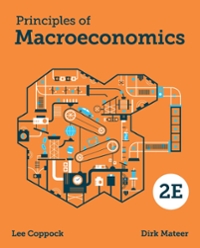Answered step by step
Verified Expert Solution
Question
1 Approved Answer
Question 1.1) Monetary policy affects which of the following variables in the medium/long run? A) the level of output B) the rate of unemployment C)
Question 1.1) Monetary policy affects which of the following variables in the medium/long run? A) the level of output B) the rate of unemployment C) the rate of inflation D) the real interest rate E) all of the above2) Which of the following is considered a benefit of inflation? A) the option of a negative real interest rate B) money illusion C) seignorage D) all of the above E) none of the above3) Which of the following is an example of the "shoe-leather costs" of inflation? A) a rise in the cost of primary raw materials, like leather for shoes B) an artificial rise in the capital gains tax C) the need to take more trips to the bank D) miscalculations due to money illusion E) All of the above4) Which of the following would serve to reduce the costs caused by the variability of inflation? A) seignorage B) bracket creep C) a higher capital gains tax D) indexed wages E) none of the above5) The nominal interest rate (in a standard economic environment) A) is never negative. B) can be negative if inflation is unexpected. C) can be negative if the inflation rate is greater than the nominal interest rate. D) can be negative if deflation occurs. E) can be negative when the real interest rate is negative. 26) When the Central Bank wants to signal the public about the direction of monetary policy, it will likely use A) a change in the discount rate. B) open market operations. C) a change in the reserve requirement. D) a public announcement about a change in the targeted federal funds rate. E) all of the above7) Monetary policy has short-run effects on which of the following? A) The level of output B) only the price level C) only the nominal interest rate, not the real interest rate D) All of the above E) none of the above8) In the medium run, an increase in inflation causes A) an increase in the opportunity cost of holding money. B) a reduction in the opportunity cost of holding money. C) no change in the opportunity cost of holding money. D) individuals to switch from holding bonds to money and increase their real money balances.9) The existence of inflation does which of the following? A) reduces tax distortions B) reduces shoe-leather costs C) allows for the possibility of negative real interest rates D) reduces the costs associated with money illusion10) An economy is said to be in the liquidity trap when the short-term ________ is down to zero. A) real interest rate on government bonds B) nominal interest rate on government bonds C) nominal borrowing rate of banks D) nominal deposit rate of banks11) In 2010, the average inflation rate in the OECD countries was A) 1.2%. B) 2.3%. C) 5.2%. D) 3.8%. E) 10.5%.12) For this question, assume that the Fed sets monetary policy according to the Taylor rule. Suppose current U.S. macroeconomic conditions are represented by the following: ?t > ?* and ut current stance of monetary policy. D) more information is need to answer this question.Question 2.Problem #1 Consider an economy with the demand side characterized by the following set of equations yt = ?t - ?(rt - p) + ?t rt = it - ?t it = ?t + p + ?? (?t - ?*) + ?y(yt - ?t) i) Derive the equation describing the DAD curve in this economy Now, assume that the Phillips curve the economy can be described with ?t = ?te + ?(yt - ?t) + vt, where ?te denotes expected - from the perspective of period t 1, inflation at time t. Furthermore, assume that expectations are formed according to ?te = ??t-1 + (1 - ?)?t ii) Derive the equation describing the DAS curve in this economy. Let the parameters assume that following values: ?t = 0, ? = 0.5, p = 0.03, ??= 0.25 , ?y = 0.75 , ?*= 0.02, and ? = 0.5 . Finally, for now assume that ? = 1. iii) Find the long run equilibrium in this economy iv) Assume that the economy has been in he long run equilibrium for some time. Use your favorite software to simulate what happens to the key economic variables if the economy experiences a temporary shock to demand. Specifically, assume that at time t we have ?t = 0, and then ?t+1 = 0.01, ?t+2 = 0.01, ?t+3 = 0.01, ?t+4 = 0.01, and then ?t+i = 0 for i ? 5. For each period, starting at period t through period t + 9, find the absolute value of the deviation of the actual output from the potential then calculate the average of the deviation. v) Redo the above exercise assuming that now ??= 0.75 and ?y=0.25 . Is the average of the deviation higher than before? vi) Now, assume again that ??= 0.25 and ?y=0.75. Redo the above exercise for the following values of ? ? {0.75, 0.5, 0.25}. For which value of is the average deviation the smallest?.


Step by Step Solution
There are 3 Steps involved in it
Step: 1

Get Instant Access to Expert-Tailored Solutions
See step-by-step solutions with expert insights and AI powered tools for academic success
Step: 2

Step: 3

Ace Your Homework with AI
Get the answers you need in no time with our AI-driven, step-by-step assistance
Get Started


